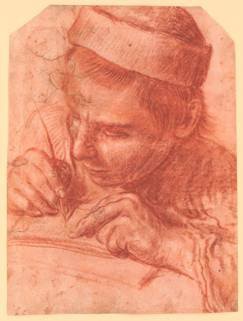Draughtsmen in Rome 1550-1700
dal 31/12/2011 al 12/5/2012
Segnalato da
Taddeo Zuccari
Federico Zuccari
Girolamo Muziano
Annibale Carracci
Caravaggio
Orazio Gentileschi
Giovanni Baglione
Alessandro Turchi
Antonio Carracci
Ottavio Leoni
Pietro da Cortona
Gian Lorenzo Bernini
Francesco Borromini
Carlo Maratta
31/12/2011
Draughtsmen in Rome 1550-1700
Pinakothek der Moderne, Munich
Works that have never been on show before, together with well-known drawings, trace the emergence and development of the Late Baroque era in Rome - one of the artistically most fruitful periods there has ever been in western art. On view 150 sheets from the holdings of the Staatliche Graphische Sammlung Munchen.

Some 150 sheets from the holdings of the Staatliche Graphische Sammlung München will be shown in the exhibition ‘Draughtsmen in Rome 1550–1700’. Works that have never been on show before, together with well-known drawings, trace the emergence and development of the Late Baroque era in Rome – one of the artistically most fruitful periods there has ever been in western art.
While Protestant reformers were caught up in theological disputes in the middle of the 16th century, the Council of Trent provided the Catholic Church with a new basis. As reforms started to take hold, Rome was gripped by a feeling of impending change. Countless artists from all over Italy descended on the city on the Tiber and were joined by others from north of the Alps, from France, Germany and the Netherlands, who offered their services to educated, wealthy and ambitious Romans interested in art and with a clearly recognisable taste.
The exhibition opens with sheets by Taddeo and Federico Zuccari. The two brothers and their colleagues drew on the balanced style of the High Renaissance, turning their backs on the crowded figurative compositions of the Mannerists. Girolamo Muziano, who trained in Venice, adopted the same style, heralding Catholicism’s newly burgeoning assertiveness in his large, peaceful drawings. Annibale Carracci of Bologna with his classically detached approach, and Caravaggio from the north of Italy with his decisively naturalistic painting, became protagonists of the new style. This is reflected in Carracci’s sheets, saturated in paradigms of nature, just as in the drawings of Orazio Gentileschi and Giovanni Baglione or Alessandro Turchi and Antonio Carracci, who pick up on Caravaggio’s ideas in their refined use of the effects of light.
The portrait specialist Ottavio Leoni can also be counted among the pioneers of this new style. His works, full of light and human warmth, influenced the art of Gian Lorenzo Bernini, who is represented in the exhibition with a self-portrait, two exceptional nude studies and architectural projects. He is flanked by his rivals Francesco Borromini and Pietro da Cortona, whose much discussed sketches for the magnificent ceiling in the salon of the Palazzo Barberini can also be seen.
A different side of the resounding Roman Baroque style is shown in the drawings of the Netherlandish artist Paul Bril, who moved away from the worldly landscapes of the Mannerists while in Rome, bathing his scenes in an atmosphere of familiarity and intimacy. Claude Lorrain, with his exceptional perspicacity, transcends the landscape in his drawings, imbuing them with a seemingly divine light. In addition to sheets of refreshing natural scenes, refined compositional studies of mythological and sometimes hermetic themes can be seen, highlighting the charm of drawing as a medium of both spontaneous invention and deliberate execution.
The exhibition concludes with sheets by the talented and multifaceted draughtsman Carlo Maratta. Pupils of this last great caposcuola in Rome, such as Michel II Corneille, for example, already provide the link to 18th-century France and to Paris that succeeded Rome as the capital of the arts.
Apart from those artists already mentioned, sheets by Adam Elsheimer, Nicolas Poussin, Guido Reni, Jusepe Ribera, Salvator Rosa and Joachim von Sandrart are also on display.
Many of the exhibited works are discussed and illustrated for the first time in a comprehensive catalogue of works, published by Deutscher Kunstverlag and generously sponsored by the Ernst von Siemens Art Foundation, that accompanies the exhibition.
The exhibition and the catalogue combine information gained from the on-going indexing of the holdings and conservational work on the sheets, many of which have scarcely been analysed to date, with an overview of an extremely fascinating phase in western art, during which draughtsmen in Rome sounded out techniques and focussed on new subjects that have hardly ever been executed with a greater vivacity and vituosity.
Image: Circle of Annibale Carracci, Boy Writing (John the Evangelist?), n.d., sanguine, 375 x 285 mm, Staatliche Graphische Sammlung München, © Staatliche Graphische Sammlung München
Press preview: 01.02.2012, 11.00
Opening: 01.02.2012, 18.30
aily except MON 10.00 a.m. - 6.00 p.m.
THU 10.00 a.m. - 8.00 p.m.
Closed: Shrove Tuesday, May Day (1 May), Christmas Eve (24 Dec.), Christmas Day (25 Dec.), New Year´s Eve (31 Dec.)
Opened: Twelfth Day (Jan. 6th), Easter Monday, Whit Monday
Pinakothek der Modern
Barer Strasse 40 - Munich
Admission: 10 euros / reduced 7 euros
Sunday admission 1 euro



